- Home
- Robert K. Massie
Nicholas and Alexandra Page 16
Nicholas and Alexandra Read online
Page 16
* Anti-Semitism, an endemic disease in Russia, stemmed from the oldest traditions of the Orthodox Church. “To the devoutly … Orthodox Russians,” explains a Jewish historian, “… the Jew was an infidel, the poisoner of the true faith, the killer of Christ.” Every tsar supported this faith. Peter the Great, refusing to admit Jewish merchants to Russia, declared, “It is my endeavor to eradicate evil, not to multiply it.” Catherine the Great endorsed Peter’s decision, saying, “From the enemies of Christ, I desire neither gain nor profit.” It was Catherine who, upon absorbing heavily Jewish regions of eastern Poland into her empire, established the Jewish Pale of Settlement, an area in Poland and the Ukraine to which all Russian Jews supposedly were restricted. The restrictions were porous, but the life of a Jew in nineteenth-century Russia remained subject to harassment and persecution. That this antagonism was religious rather than racial was repeatedly illustrated by cases of Jews who gave up their faith, accepted Orthodoxy and moved freely into the general structure of Russian society.
* The era was one of bitter labor strife in all industrial nations. In the United States, for example, during the Pullman strike of 1894, Judge William Howard Taft, a future President, wrote to his wife, “It will be necessary for the military to kill some of the mob before the trouble can be stayed. They have killed only six as yet. This is hardly enough to make an impression.” In the end, 30 were killed, 60 wounded and 700 arrested. Six years later, Theodore Roosevelt, campaigning for Vice President, said privately, “The sentiment now animating a large proportion of our people can only be suppressed … by taking ten or a dozen of their leaders out, standing them against the wall and shooting them dead. I believe it will come to that. These leaders are planning a social revolution and the subversion of the American Republic.”
PART TWO
CHAPTER TEN
The Tsar’s Village
THE secret of Alexis’s disease was hidden and carefully guarded within the inner world of Tsarskoe Selo, “the Tsar’s village.” “Tsarskoe Selo was a world apart, an enchanted fairyland to which only a small number of people had the right of entry,” wrote Gleb Botkin, the son of Nicholas II’s court physician. “It became a legendary place. To the loyal monarchists, it was a sort of terrestrial paradise, the abode of the earthly gods. To the revolutionaries, it was a sinister place where blood-thirsty tyrants were hatching their terrible plots against the innocent population.”
Tsarskoe Selo was a magnificent symbol, a supreme gesture, of the Russian autocracy. At the edge of the great St. Petersburg plain, fifteen miles south of the capital, a succession of Russian tsars and empresses had created an isolated, miniature world, as artificial and fantastic as a precisely ordered mechanical toy. Around the high iron fence of the Imperial Park, bearded Cossack horsemen in scarlet tunics, black fur caps, boots and shining sabers rode night and day, on ceaseless patrol. Inside the park, monuments, obelisks and triumphal arches studded eight hundred acres of velvet green lawn. An artificial lake, big enough for small sailboats, could be emptied and filled like a bathtub. At one end of the lake stood a pink Turkish bath; not far off, a dazzling red-and-gold Chinese pagoda crowned an artificial hillock. Winding paths led through groves of ancient trees, their massive branches latticed for safety with cables and iron bars. A pony track curved through gardens planted with exotic flowers. Scattered in clumps throughout the park were lilacs planted by a dozen empresses. Over the years, the shrubs had grown into lush and fragrant jungles. When the spring rain fell, the sweet smell of wet lilacs drenched the air.
Tsarskoe Selo sprang up when Catherine I, the lusty wife of Peter the Great, wanted a country retreat from the granite city her husband was building on the Neva marshes. Peter’s daughter, Elizabeth, displayed her parents’ instinct for grand construction. At a cost of ten million roubles, she built the Winter Palace in St. Petersburg and then turned her attention to Tsarskoe Selo. Disliking the joggling carriages which bore her in and out of the city, she began constructing a canal so that she could make the journey entirely by water. Elizabeth died before the canal was finished, but the completed sections provided excellent bathing for the inhabitants of Tsarskoe Selo.
The two palaces standing five hundred yards apart in the Imperial Park during the reign of Nicholas II had been built by Empress Elizabeth and by Catherine the Great. In 1752, Elizabeth ordered the famous architect Rastrelli to build a palace at Tsarskoe Selo which would outshine Versailles. Rastrelli erected the big blue-and-white palace now called the Catherine Palace, an ornate structure with more than two hundred rooms. It pleased Elizabeth so much that she made Rastrelli a Russian count. Mingling taste with exquisite diplomacy, the French ambassador at Elizabeth’s court told the Empress that her beautiful palace lacked only one thing—a cover of glass to protect so breathtaking a masterpiece. In 1729, Catherine the Great commissioned another Italian, Quarenghi, to build a second, smaller palace at Tsarskoe Selo for her beloved grandson, the boy who was to become Alexander I. Quarenghi’s building, the Alexander Palace, was as simple as the Catherine Palace was ornate. It was here, to the Alexander Palace, that Nicholas II brought his bride to live in the spring of 1895. It remained their home for twenty-two years.
In describing palaces, simplicity becomes a relative term. The Alexander Palace had over one hundred rooms. From the tall windows of the Catherine Palace, the Tsar and his wife gazed down on terraces, pavilions, statues, gardens and ornate carriages drawn by magnificent horses. Inside the palace were long, polished halls and tall, shaded rooms furnished in marble, mahogany, gold, crystal, velvet and silk. Beneath huge chandeliers, rich Oriental rugs were spread on gleaming parquet floors. In winter, sapphire-and-silver brocade curtains helped to shut out the murky chills of Russian twilight. Large multicolored porcelain stoves warmed the cold rooms, mingling the smell of burning wood with the fragrant scent provided by smoking pots of incense carried by footmen from room to room. In every season, Empress Alexandra filled the palace with flowers. When autumn frosts ended the growing in the gardens and greenhouses at Tsarskoe Selo, flowers were brought by train from the Crimea. Every room had its swirl of odors; the sweetness of lilies in tall Chinese vases, the delicate fragrance of violets and lilies of the valley bunched in silver bowls, the perfume of hyacinths in rare lacquered pots.
To guard this paradise, to tend its lawns and pick its flowers, to groom its horses, polish its motorcars, clean its floors, make its beds, polish its crystal, serve its banquets and bathe and dress its Imperial children took thousands of human hands. Besides the Cossacks, a permanent garrison of five thousand infantrymen carefully chosen from all the regiments of the Imperial Guard provided guard detachments at the palace gates and foot patrols in the Imperial Park. Thirty sentries were always stationed inside the palace, in vestibules, corridors, staircases, kitchens and even in the cellars. The guardsmen were supplemented by plainclothes police who inspected the servants, tradesmen and workmen and kept notebook records of all who came and went. In bad weather, the Tsar could look from any window and see a tall soldier in a long greatcoat, cap and boots pacing his round. Not far away, there was usually a forlorn policeman with galoshes and umbrella.
Inside, an army of servants in gorgeous livery moved through the polished halls and silken chambers. Equerries in red capes bordered with Imperial eagles, and hats waving long red, yellow and black ostrich plumes, stepped noiselessly on the soft soles of their patent-leather shoes. “Resplendent in snow white garters, the footmen ran before us up the carpeted staircases,” wrote one visitor to the Imperial palace. “We passed through drawing rooms, ante-rooms, banqueting rooms, passing from carpets to glittering parquet, then back to carpets.… At every door stood lackeys petrified in pairs in most varied costumes, according to the room to which they were attached; now the traditional black frock coats, now Polish surcoats, with red shoes and white stockings and gaiters. At one of the doors [stood] two handsome lackeys with … crimson scarves on their heads, caught up with tinsel clasps.”
Nothing had changed, neither the trappings nor the rhythm of palace life, since the days of Catherine the Great. Court protocol, handed down from a forgotten era, remained as obstinately rigid as a block of granite. In the palace, courtiers backed away from the presence of the sovereigns. No one ever contradicted a member of the Imperial family. It was improper to speak to a member of the family without being spoken to, and when walking with the sovereigns, friends did not greet each other or even notice each other’s existence unless an Imperial personage did so first.
Frequently, court protocol almost seemed to conduct itself, taking its own course, making its own decisions, running on its own vast internal energies of tradition, exclusive of all human management. One day Dr. Botkin, the court physician, was surprised to receive the award of the Grand Cordon of the Order of St. Anna. According to protocol, he asked for a formal audience with the Tsar to thank him for the decoration. As he saw Botkin daily in his capacity as physician, Nicholas was surprised by the request. “Has anything happened that you want to see me officially?” he asked. “No, Sire,” said Botkin, “I came only to thank Your Majesty for this.” He pointed to the star pinned on his chest. “Congratulations,” said Nicholas, smiling. “I had no idea I had given it to you.”
Everything at Tsarskoe Selo centered on the Tsar. Outside the palace gates, Tsarskoe Selo was an elegant provincial town dominated by the life and gossip of the court. The mansions of the aristocracy, lining the wide tree-shaded boulevard which led from the railway station to the gates of the Imperial Park, pulsed with the rhythm that emanated from the Imperial household. A week of excited conversation could follow a nod, a smile or a word sent by the sovereign in an unusual direction. Severe crises arose over matters of promotion, decorations and clashing appointments for tea. Invitations to the palace were hoarded like diamonds. No greater delight offered itself than to have the telephone ring and hear one of the deep male voices of the palace telephone operators announce, “You are called from the apartments of Her Imperial Majesty” or, if the caller was one of Her Majesty’s daughters, “You are called from the apartments of Their Imperial Highnesses.”
The master of court life, the impresario of all court ceremonies, the bestower of all stars and ribbons, the arbitrator of all court disputes, was a Finnish nobleman advanced in years, Count Vladimir Fredericks. In 1897, at the age of sixty, Fredericks became chief minister of the Imperial court; he held the post until 1917, when it ceased to exist. Nicholas and Alexandra were devoted to “the Old Man,” as they referred to Fredericks. He, in turn, treated them as his own children and in private addressed them as “mes enfants.”
Fredericks, according to Paléologue, the French Ambassador, was “the very personification of court life. Of all the subjects of the Tsar, none has received more honors and titles. He is Minister of the Imperial court and household, aide-de-camp to the Tsar, cavalry general, member of the Council of Empire.… He has passed the whole of his long life in palaces and ceremonies, in carriages and processions, under gold lace and decorations.… He knows all the secrets of the Imperial family. In the Tsar’s name he dispenses all the favors and gifts, all the reproofs and punishments. The grand dukes and grand duchesses overwhelm him with attention for he it is who controls their households, hushes up their scandals and pays their debts. For all the difficulties of his task he is not known to have an enemy, such is the charm of his manner and his tact. He is also one of the handsomest men of his generation, one of the finest horsemen, and his successes with women were past counting. He has kept his lithe figure, his fine drooping mustache, and his charming manners … he is the ideal type for his office, the supreme arbitrator of the rites and precedences, conventions and traditions, manners and etiquette.”
As old age crept over him, Fredericks became ill and his energies sagged. He dozed off in the middle of conferences. He became forgetful. During the war, Prince Bariatinsky arrived at the palace to present the Tsar with the military order of the Cross of St. George. “Fredericks went to announce the Prince to His Majesty,” wrote Botkin, “but on his way from one room to the other, forgot what he was supposed to do, and wandered off, leaving the Emperor to wait for the Prince in one room and the Prince to wait for the Emperor in an adjoining room, both bewildered and angry at the delay.” Another time, Fredericks approached the Tsar and said, “I say, did His Majesty invite you for dinner tonight?” When Nicholas looked at him in utter bewilderment, Fredericks said, “Oh, I thought you were somebody else.”
After Fredericks, Nicholas’s favorite among the inhabitants of his court was Prince Vladimir Orlov, Chief of the Tsar’s Private Secretariat. A highly cultivated, sarcastic man and a descendant of one of the lovers of Catherine the Great, the Prince was known as “Fat Orlov” because he was so obese that, when sitting, he was unable to see his own knees. Orlov had been a cavalry officer, but in middle age he no longer was able to mount a horse. At parades when the Tsar and the Imperial suite rode by on horseback, Orlov was seen in the middle of the cavalcade, marching along on foot.
Naturally, these courtiers were fervent monarchists, “plus royaliste que le roi.” The Russia that men like Orlov preferred to see was a land of meek, sentimental, devoutly religious moujiks, overwhelmingly loyal to the Tsar. Russia’s enemies, they believed, were those who degraded the autocracy—the politicians and parliamentarians as well as the revolutionaries. This view, sounded in Nicholas’s ear whenever he would listen, survived defeats in war, revolutionary upheavals, the rise and fall of ministers and Imperial Dumas. Year after year slipped away, wrote Botkin, and “the enchanted little fairyland of Tsarskoe Selo slumbered peacefully on the brink of an abyss, lulled by the sweet songs of bewhiskered sirens who gently hummed ‘God Save the Tsar,’ attended church with great regularity … and from time to time asked discreetly when they were going to receive their next grand cordon or advance in rank or raise in salary.”
A graceful two-story building in simple classical style, the Alexander Palace at Tsarskoe Selo was made up of a center and two wings. In the central building were clustered the state apartments and formal chambers. The ministers of court and ladies- and gentlemen-in-waiting had apartments in one of the two wings. In the other wing, Nicholas and Alexandra established a world and led a carefully scheduled and domestic existence.
The Empress Alexandra’s first command as a bride was that the rooms of this wing be redecorated. Curtains, rugs, upholstering and pillows were done in bright English chintzes and in mauve, her favorite color. On the second floor, the rooms selected as nurseries were cleared of heavy furniture, and simple beds and dressers of lemon-wood were installed, with covers of cheerful English cretonne. Under her direction, the general appearance of the private wing became that of a comfortable English country house.
Mounting guard over the frontier between this private world and the rest of the palace was a gaudily fantastic quartet of bodyguards. Four gigantic Negroes dressed in scarlet trousers, gold-embroidered jackets, curved shoes and white turbans stood guard outside the study where the Tsar was at work, or the boudoir where the Empress was resting. “They were not soldiers,” wrote Alexandra’s friend Anna Vyrubova, “and had no function except to open and close doors and to signal by a sudden noiseless entrance into a room that one of Their Majesties was about to appear.” Although all of these men were referred to at court as Ethiopians, one was an American Negro named Jim Hercules. Originally a servant of Alexander III, Hercules was an employee, bound to the family only by loyalty. He took his vacations in America and brought back jars of guava jelly as presents for the children.
Behind the heavy doors guarded by this flamboyant quartet, the Imperial family lived a punctual existence. In the winter, Tsarskoe Selo lay under a heavy blanket of snow and the sun did not come until nine o’clock. Nicholas rose at seven, dressed by lamplight, had breakfast with his daughters and disappeared into his study to work. Alexandra rarely left her room before noon. Her mornings were spent propped up on pillows in bed or on a
chaise-longue, reading and writing long emotional letters to her friends. Unlike Nicholas, who wrote painstakingly and sometimes took hours to compose a letter, Alexandra wrote voluminously, dashing off lengthy sentences across page after page, punctuating only with dots and dashes and exclamation points. At her feet, while she wrote, lay a small shaggy Scotch terrier named Eira. Most people considered Eira disagreeable; he liked to dart from under tables and nip at heels. Alexandra doted on him and carried him from room to room—even to the dinner table.
Unlike many a royal couple, Nicholas and Alexandra shared the same bed. The bedroom was a large chamber with tall windows opening onto the park. A large double bed made of light-colored wood stood between two windows. Chairs and couches covered in flowered tapestry were scattered about on a thick carpet of mauve pile. To the right of the bed, a door led to a small chapel used by the Empress for her private prayers. Dimly lit by hanging lamps, the room contained only an icon on one wall and a table holding a Bible. Another door led from the bedroom to Alexandra’s private bathroom, where a collection of old-fashioned fixtures were set in a dark recess. Primly Victorian, Alexandra insisted that both bath and toilet be covered during the day by cloths.
The most famous room in the palace—for a time the most famous room in Russia—was the Empress’s mauve boudoir. Everything in it was mauve: curtains, carpet, pillows; even the furniture was mauve-and-white Hepplewhite. Masses of fresh white and purple lilacs, vases of roses and orchids and bowls of violets perfumed the air. Tables and shelves were cluttered with books, papers and porcelain and enamel knicknacks.* In this room, Alexandra surrounded herself with mementoes of her family and her religion. The walls were covered with icons. Over her chaise-longue hung a picture of the Virgin Mary. A portrait of her mother, Princess Alice, looked down from another wall. On a table in a place of honor stood a large photograph of Queen Victoria. The only portrait in the room other than religious and family pictures was a portrait of Marie Antoinette.

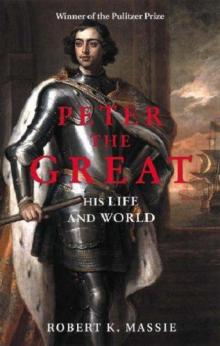 Peter the Great
Peter the Great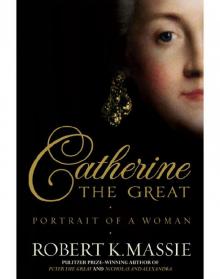 Catherine the Great
Catherine the Great Dreadnought
Dreadnought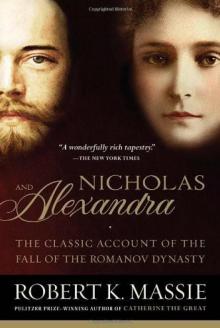 Nicholas and Alexandra: The Classic Account of the Fall of the Romanov Dynasty
Nicholas and Alexandra: The Classic Account of the Fall of the Romanov Dynasty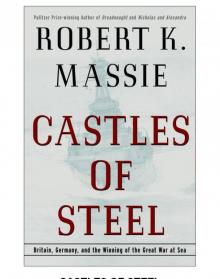 Castles of Steel
Castles of Steel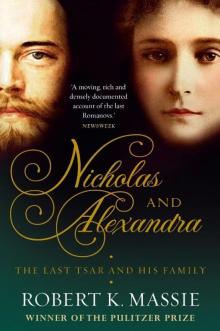 Nicholas and Alexandra: The Tragic, Compelling Story of the Last Tsar and his Family
Nicholas and Alexandra: The Tragic, Compelling Story of the Last Tsar and his Family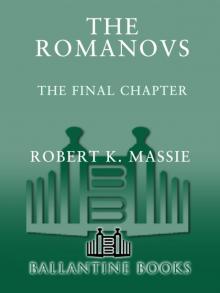 The Romanovs
The Romanovs Dreadnought, Britain, Germany and the Coming of the Great War
Dreadnought, Britain, Germany and the Coming of the Great War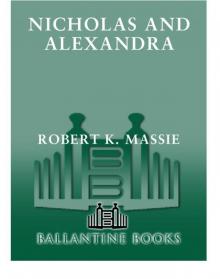 Nicholas and Alexandra
Nicholas and Alexandra